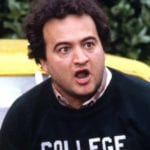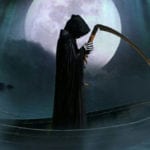 Politics
Politics  Politics
Politics  Weird Stuff
Weird Stuff Ten Bizarre Facts About The Doge Meme
 Our World
Our World 10 Ways Your Christmas Tree Is More Lit Than You Think
 Movies and TV
Movies and TV The 10 Coolest Stars to Set Sail on The Love Boat
 History
History 10 Things You Didn’t Know About the American National Anthem
 Technology
Technology Top 10 Everyday Tech Buzzwords That Hide a Darker Past
 Humans
Humans 10 Everyday Human Behaviors That Are Actually Survival Instincts
 Animals
Animals 10 Animals That Humiliated and Harmed Historical Leaders
 History
History 10 Most Influential Protests in Modern History
 Creepy
Creepy 10 More Representations of Death from Myth, Legend, and Folktale
 Politics
Politics 10 Political Scandals That Sent Crowds Into the Streets
 Weird Stuff
Weird Stuff Ten Bizarre Facts About The Doge Meme
 Our World
Our World 10 Ways Your Christmas Tree Is More Lit Than You Think
Who's Behind Listverse?

Jamie Frater
Head Editor
Jamie founded Listverse due to an insatiable desire to share fascinating, obscure, and bizarre facts. He has been a guest speaker on numerous national radio and television stations and is a five time published author.
More About Us Movies and TV
Movies and TV The 10 Coolest Stars to Set Sail on The Love Boat
 History
History 10 Things You Didn’t Know About the American National Anthem
 Technology
Technology Top 10 Everyday Tech Buzzwords That Hide a Darker Past
 Humans
Humans 10 Everyday Human Behaviors That Are Actually Survival Instincts
 Animals
Animals 10 Animals That Humiliated and Harmed Historical Leaders
 History
History 10 Most Influential Protests in Modern History
 Creepy
Creepy 10 More Representations of Death from Myth, Legend, and Folktale
10 Incredibly Dark Stories Behind Influential Songs
Art imitates life, and indeed, life imitates art. As life contains moments of sadness and joy, these things tend to show up in pieces of art, and popular songs are no exception. That said, sometimes tragic or disastrous occurrences were necessary for some of the most legendary songs to be written.
Here are 10 popular songs that are footnoted with unfortunate events. Some were inspired by catastrophes such as descent into madness, destruction, and death, whereas others portended misfortunes yet to come. Sometimes, it was a case of both.
10 “Smoke On The Water” By Deep Purple
In December 1971, Deep Purple arrived in Switzerland to record their groundbreaking album Machine Head at the Montreux Casino using the Rolling Stones Mobile Studio. Having performed there earlier in the year, the band were fond of the venue and had good relations with its owner, Claude Nobs.
The night before recording commenced, the Casino hosted a concert by Frank Zappa and the Mothers of Invention. A little more than a few hours into Zappa’s set, the concert was interrupted when a member of the audience fired a distress rocket into a rattan-covered ceiling. A fire broke out instantly, and though nobody was seriously hurt, the flames laid waste to the entire Montreux Casino complex, along with all of Frank Zappa’s equipment and Deep Purple’s recording plans.
After a false start at a nearby theater called the Pavillion, during which the sessions were undermined by locals complaining to the police about the noise, the band relocated to the out-of-season Grand Hotel. Amidst the chaos, the first track recorded was a mid-tempo rocker anchored by a simple riff consisting of four inverted power chords, inspired in part by the intro to the first movement of Beethoven’s Fifth Symphony. Bassist Roger Glover came up with the title “Smoke On The Water” after recalling the pall of smoke blown over Lake Geneva as the fire gutted the Casino. Almost instantly, he and singer Ian Gillan wasted no time putting words together that told the story of the chaos surrounding the recording sessions, thus creating one of the best-loved and most memorable songs in the history of hard rock.
“What I love about ‘Smoke On The Water,’ ” recounted organist Jon Lord, “if you want to know the story, listen to the words.”
9 “Castles Made Of Sand” By The Jimi Hendrix Experience
The second track on the second side of virtuoso guitarist and legendary songwriter Jimi Hendrix’s second album is an astute but melancholy observation of the temporary nature of existence. The first verse speaks of a romantic relationship crumbling in the wake of a drunken argument, which is no doubt a reference to the stormy love affair between Hendrix and Kathleen Mary Etchingham, who also inspired “The Wind Cries Mary.” The second verse is about an Indian brave killed in his sleep by a sneak attack on the eve of his first battle and a disabled girl who finds solace by deciding to end her ruined and embittered life.
Nonetheless, many see “Castles Made of Sand” as an allegory for Hendrix’s own inner life. He was born into a poor, itinerant family, his siblings were placed in foster care, and his mother died in 1958 after years of alcohol abuse when Hendrix was 16. Indeed, the second verse about the Indian brave whose dream of becoming a warrior was eclipsed as a “surprise attack killed him in his sleep” proved prophetic. On the morning of September 18, 1970, Hendrix—who had Cherokee ancestry—took nine sodium Seconal tablets to help himself fall asleep after partying all night. He never woke up, as a result of underestimating the potency of the pills he ingested, and died after vomiting and asphyxiating while unconscious. He was 27 years old.
8 “Highway To Hell” By AC/DC
By the start of 1979, Ronald Belford “Bon” Scott, a pint-sized hellraiser with a larger-than-life personality and an outsized voice, had finally begun to strike pay dirt. He’d spent the previous five years going from strength to strength cutting records and pounding stages with AC/DC, a formidable blues-based rock outfit originating from Sydney, Australia formed by guitarist brothers Angus and Malcolm Young. That year, the quintet would release the groundbreaking album Highway to Hell, a title that shocked their label, Atlantic Records. “They freaked with that title,” remembered Malcolm Young. Nonetheless, the band stuck to their guns. “I said ‘hogwash,’ ” said Angus Young. “We’re calling it Highway to Hell and that’s how it is.”
Despite the perceived connotations of Satanism that worried the record company and made them plenty of enemies among religious fundamentalists, the song “Highway to Hell” had nothing to do with devil worship and everything to do with the rigors of being on the road in a working rock outfit. “When there’s five of you sleeping in a van,” said Angus in one interview, “and the singer’s dirty sock is two inches away from your nose, that’s pretty close to hell.” Longtime drummer Phillip Rudd concurred “If you had been on the road with us for those years up to that point, you would have understood exactly what we were talking about.” Indeed, weariness had crept into Scott’s lyrics. In an interview shortly before his passing, he remarked “We’ve been working nonstop since the band started. We’ve just got to have a break occasionally.”
It seems fitting that an album called Highway to Hell would be the last one Bon Scott recorded with AC/DC. However, all the more foreboding was the fact that the album’s title track was the last song Bon Scott performed with AC/DC on February 9, 1980 on a Spanish television program called Aplauso. At the very end of the song, amidst the applause of the studio audience, a freeze frame is shown in which all of the members of AC/DC are present except for Bon Scott.
On the night of February 18, 1980, Bon Scott went out for drinks in London at a club then called the Music Machine, where he downed measure after measure of Scotch whiskey. During the night, suffering alcohol poisoning, he died in his sleep after asphyxiating on his own vomit. He was 33 years old. As inadvertently predicted by the freeze frame at the end of the Aplauso broadcast, AC/DC found themselves at a standstill with no lead singer. They considered disbanding, but with the blessing of Bon’s parents, they opted to continue, recruiting Newcastle native Brian Johnson to step up to the microphone. He would give a voice to what would be their most successful album, Back in Black, which was conceived as a requiem for Bon, and still sings for AC/DC to this day.
7 “Shine On, You Crazy Diamond” By Pink Floyd
On January 6, 1975, British progressive rock band Pink Floyd were riding a wave of success on Dark Side of the Moon, a sophisticated concept album about the things in life that break people’s spirits. They returned to Abbey Road studios to begin work on their follow-up, Wish You Were Here. It was a concept album that touched on such themes as absence, the corruption within the music business, and the drug-induced mental collapse of their founder and original leader, Roger Keith Barrett, better known to the world at large as “Syd.” The nine-part epic song that begins and ends the album, “Shine On, You Crazy Diamond,” was no doubt written specifically as a tribute to Syd. Coincidentally, the day the sessions commenced was also Syd Barrett’s 29th birthday.
Near the end of the album’s sessions, as the vocals for “Shine On” were being completed, the band noticed a heavyset man with a shaved head and eyebrows who had wandered into the studio, his mental state later described by drummer Nick Mason as “desultory and not entirely sensible.”
“Roger [Waters, the bass player] was there, and he was sitting at the desk, and I came in and I saw this guy sitting behind him—huge, bald, fat guy,” recalled keyboardist Richard Wright in a 1984 interview. “I thought, ‘He looks a bit . . . strange . . . ’ Anyway, so I sat down with Roger at the desk and we worked for about ten minutes, and this guy kept on getting up and brushing his teeth and then sitting—doing really weird things, but keeping quiet. And I said to Roger, ‘Who is he?’ and Roger said ‘I don’t know,’ and I said ‘Well, I assumed he was a friend of yours,’ and he said ‘No, I don’t know who he is.’ Anyway, it took me a long time, and then suddenly I realized it was Syd, after maybe 45 minutes.”
When the others realized that the strange man was indeed their erstwhile leader, now a shadow of his former self, they were horrified. Waters was even reduced to tears. Syd willingly told the band he was happy to lend his services to them, but it was clear to all present that he was in no shape to perform in a band with anyone. He had, in fact, already withdrawn from performing and recording music the year before following an abortive attempt at a solo recording. After that session, none of the members of Pink Floyd would see Syd again, as he would eventually permanently retreat to his hometown of Cambridge, England, where he died in 2006 from complications of diabetes at age 60.
6 “Buried Alive In The Blues” By Janis Joplin & The Full Tilt Boogie Band
In September 1970, Janis Joplin, a diminutive singer with a big bluesy voice and attitude to match, traveled to Hollywood with the Full Tilt Boogie Band to record Pearl. It was a long-player that would become her most polished and successful recording ever, holding the #1 spot on the Billboard 200 for nine weeks. Although Janis had been using heroin during this period, the morale in the studio was undoubtedly high. The songs chosen for the album included “Trust Me,” written for her by soul legend Bobby Womack, and “Me and Bobby McGee,” co-written by Kris Kristofferson and Fred Foster. The latter would become Janis Joplin’s first number one single.
Sadly, Janis did not get a chance to enjoy this success. In fact, she did not even get to finish the album that would consolidate her legendary reputation. On October 1, 1970, Joplin took to the studio to record the a capella song “Mercedes Benz” in one take and a quick birthday serenade to John Lennon, who would soon turn 30. These proved to be the final vocal performances she ever committed to tape. Two days later, she visited the studio to hear the instrumental track for the song “Buried Alive in the Blues,” which was gifted to her by tunesmith Nick Gravenites. Satisfied with the recording, she announced to producer Paul Rothchild that she would add her vocal to tape the next day before going out drinking at Barney’s Beanery, a high-end bar and restaurant in West Hollywood. She then retired to the Landmark Motor Hotel, where she had been staying since her arrival in California.
The next day, Janis was conspicuously absent at the studio, much to the concern of Paul Rothchild. John Cooke, the road manager of the Full Tilt Boogie Band, drove to the Landmark Motor Hotel to check on her. In the parking lot, he saw her pyschedelically-painted Porsche 356 rag-top convertible, and when he stepped inside room #150, he found Janis lying dead on the floor between her bed and the table beside it with a fresh needle mark in her arm. She had a cigarette that had burned down to the filter in one hand and four dollar bills in the other. As she fell forward in her death throes, she had struck her face on the bedside table, bloodying her lip. Shortly afterward, an inquest undertaken by the Los Angeles County Coroner’s Office determined that Janis Lyn Joplin, 27, had died of a heroin overdose compounded by alcohol use.
Sessions for her album were abruptly halted and “Buried Alive in the Blues” was kept as an instrumental. Although Pearl ended up being incomplete, it became her best-selling album upon its release in January 1971.
5 “The Needle And The Damage Done” By Neil Young
Neil Young’s mournful song “The Needle and the Damage Done” clearly relates the tragic tale of Neil Young’s friend and colleague from his backing band Crazy Horse, Daniel Ray Whitten, who was riddled with heroin addiction. Recorded live in concert at UCLA’s Royce Hall in 1971 and included on Young’s 1972 album Harvest, this composition was characteristically personal, in particular the line “I hit the city and I lost my band.” This was a reference to Young opting to dismiss Crazy Horse from the sessions for his 1970 album After The Gold Rush, ostensibly because of the drug abuse undermining the recording sessions.
Sadly, Whitten was never able to escape his demons. Though by 1972 he had been drafted to play guitar on the tour to support Harvest, he showed up to rehearsals strung out on junk and unable to keep up with the rest of the band. On November 18, an exasperated Neil Young once again fired Danny Whitten, giving him $50 and a plane ticket back to Los Angeles. Later that night, Whitten fatally overdosed on a lethal mixture of Valium and alcohol, which he had been using to combat heroin withdrawal symptoms.
Neil Young felt a great deal of personal responsibility for years afterward. In the liner notes to his triple-album compilation Decade, he said of the song “I am not a preacher, but drugs killed a lot of great men.”
4 “Fruit Tree” By Nick Drake
Nicholas Rodney Drake was born on June 19, 1948 in Rangoon, Myanmar to English parents and raised in Tanworth-in-Arden, Warwickshire in the British Midlands, just south of Birmingham. He learned to play the saxophone, clarinet, and piano while a pupil at Marlborough College, later taking up guitar at the age of 17. Just before the end of his teens, he began gigging in coffeehouses in and around London and was discovered by Ashley Hutchings, who was playing bass in the English folk-rock group Fairport Convention at the time.
Hutchings was impressed with Drake’s skill as a guitarist and introduced him to Boston-born record producer Joe Boyd, who had worked on Pink Floyd’s first single as well as several early albums by Fairport Convention. In 1968, Nick Drake signed with Island Records and work commenced on his debut album Five Leaves Left. Its title came from the warning label concealed in packets of rolling papers, as Drake had been a longtime smoker of tobacco and cannabis.
Released in September 1969, the album was praised as “poetic” and “interesting” by British music magazine Melody Maker. The inclusion of the song “Time Has Told Me” on an Island Records sampler—as well as airplay from influential DJ John Peel—increased Drake’s exposure, but the publicity-shy Drake was unhappy with the album’s release. Moreover, low sales and lackluster performances began to aggravate the depression that plagued him for the rest of his short life.
Though Five Leaves Left is a particularly strong collection of songs, one track that stands out lyrically, “Fruit Tree,” appears to have foreboding significance: “Fame is but a fruit tree, so very unsound / It can never flourish ’til its stock is in the ground / So men of fame can never find a way / ‘Til time has flown far from their dying day / Forgotten while you’re here, remembered for a while / A much updated ruin from a much outdated style.” This verse of “Fruit Tree” seems to foreshadow Drake’s death by an overdose of antidepressants five years later in 1974. Though perhaps Drake had begun to grow tired of life during his days as a student at Cambridge University, it would appear that he was keenly and presciently aware of his destiny.
Although the albums he released during his lifetime attracted little or no interest while he was alive, he was later lauded as an influence by such songwriters as Robyn Hitchcock of the Soft Boys, REM’s Michael Stipe, and Robert Smith of the Cure, who has alleged that he named his band after a line in “Time Has Told Me.” At the end of the 20th century, Drake’s song “Pink Moon” was used in a commercial for German automobile company Volkswagen, which saw an exponential increase in sales.
3 “I Wish It Would Rain” By The Temptations
Though the Temptations did not write any of the hit singles released during their heyday from 1964–1968, the group contained singers who had a knack for interpreting the songs given to them with great feeling. One of them was David Ruffin, who lent his anguished tenor to their 1967 classic “I Wish It Would Rain,” a ballad about a heartbroken man scorned by his wife who wishes for the clouds to burst and the raindrops to hide the tears he cried for his lost love.
Though Motown songs are known for their powerful urgency, “I Wish It Would Rain” proved to be a song that was brimming with genuine and formidable emotion. Lyricist Roger Penzabene, who had also composed the Temptations’ #3 hit “You’re My Everything,” had written “I Wish It Would Rain” not long after discovering his own wife had been unfaithful to him. Deeply distraught, he took his life on December 31, 1967, a mere 10 days after “I Wish It Would Rain” was released as a single.
2 “People Who Died” By The Jim Carroll Band
Despite the fact that these punky twelve-bar blues sound mighty upbeat, the lyrics are as true-to-life and direct as they are mournful. Jim Carroll name-checks the numerous friends with whom he grew up on the Lower East Side of his native New York City and lost to misadventure, suicide, illness, drug abuse, war, and murder. Two of the people mentioned—Teddy, who fell to his death from a rooftop after sniffing glue, and Eddie, who sustained a stab wound in the jugular vein—were also referred to respectively in Carroll’s literary works The Basketball Diaries and The Book of Nods.
In 1982, “People Who Died” was used by director Steven Spielberg in his film ET the Extra-Terrestrial, enabling Jim Carroll to receive substantial royalties. Though Carroll’s poetry, prose, and songs netted him a sizable and devoted cult following, he would join his friends in death on September 11, 2009. He succumbed to heart failure at age 60 after decades of heroin addiction.
1 “Gimme Shelter” By The Rolling Stones
Keith Richards began working on the music for the song “Gimme Shelter” around the time that his songwriting partner, Mick Jagger, was acting in the bizarre British gangster film Performance. Upon his return, Jagger added fearful lyrics to Richards’s moody instrumental, inspired by the dicey state of world affairs during the late 1960s on account of the Vietnam War. At the suggestion of producer Jimmy Miller, who also provided percussion on the track, soul singer Merry Clayton was brought in to sing a duet with Jagger. Her spine-chilling soprano made this song a standout among the Rolling Stones’ classics.
The song has become synonymous with impending catastrophe. Movie director Martin Scorsese has used it to great effect during scenes in his gangster movies Goodfellas, Casino, and The Departed that presaged disaster. The song’s name was also used as the title for the documentary by Albert and David Maysles about the 1969 tour undertaken by the Rolling Stones in support of the album Let It Bleed.
The album’s title proved all the more fitting when, at the conclusion of the tour, blood was spilled on December 6, 1969 at the Altamont Free Concert. A teenager named Meredith Curley Hunter, clad in a flashy lime-green suit and high on methamphetamine, began brandishing a revolver near the stage during the Stones’ set. He was swiftly set upon by members of the Hell’s Angels Motorcycle Club, who had been called upon to provide security at the event. Hunter was stabbed and stomped to death by the Angels as the cameras rolled. For many, this fatality seemed to signal the end of the Flower Power Dream, but for the Hell’s Angels, it was business as usual.
Perhaps the most sinister circumstance surrounding the recording of “Gimme Shelter” was the fact that Clayton, heavily pregnant during the sessions, suffered a miscarriage upon her return to New Orleans from the sessions with the Stones in London, blaming the tremendous strain of recording take after take of her intense duet with Jagger. Buoyed by her Christian upbringing, Clayton was philosophical about her personal tragedy, and even released her own version of the song not long after the Stones’ recording climbed the charts.
“That was a dark, dark period for me, but God gave me the strength to overcome it,” she recalled in a 1986 interview with The Los Angeles Times. “I turned it around. I took it as life, love, and energy and directed it in another direction, so it doesn’t really bother me to sing ‘Gimme Shelter’ now. Life is short as it is and I can’t live on yesterday.”
In addition to a lifelong interest in music, art, film, and literature, James Conrad is the author of three novels, all of which can be purchased by clicking these links.








